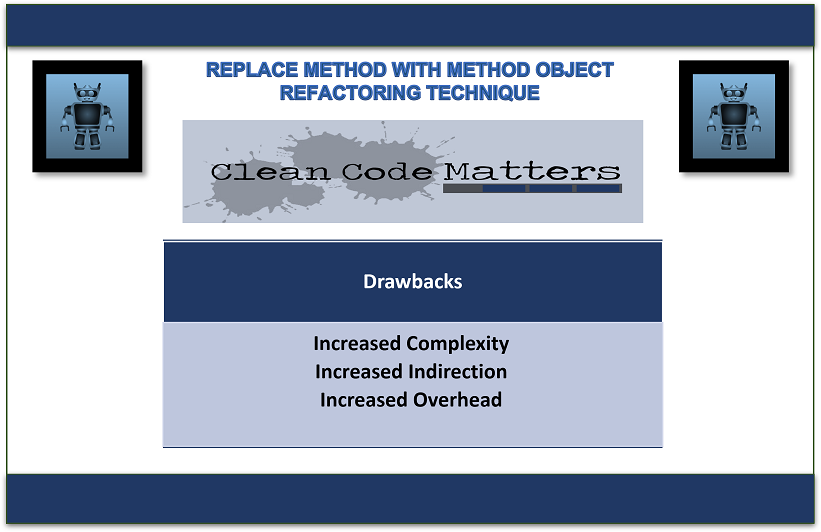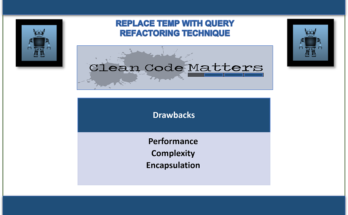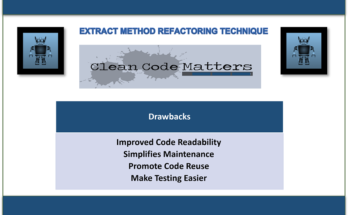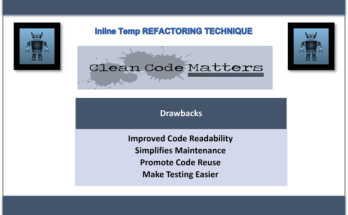The Method to Replace By enclosing difficult methods within a different class, the object refactoring technique can be used to enhance the design and organization of these methods. This refactoring technique is especially helpful when a function is too complicated or huge, making it challenging to comprehend, maintain, or test. Replace Method with Method Object is the technique that makes the code cleaner and clearer.
Ways to Apply the Replace Method with Method Object Refactoring Technique?
The Replace Method with Method Object refactoring approach is explained in detail here:
- Determine the intended technique: Choose the method that has to be refactored. Search for procedures that are lengthy, have several different roles, or have complicated conditional logic.
- Make a brand-new class: Make a new class that will operate as the refactored method’s container. This class ought to be given a name that accurately describes its function.
- Transfer method code: The target method’s complete body should be copied and pasted into a new method inside the newly created class. The name of the new technique must be the same as the old one.
- Method parameters should be noted. List any local variables or parameters that the original method used. These will turn into new class instance variables.
- Identify any external resources or dependencies that the original method used and encapsulate them. Either through constructor parameters or setter methods, these dependencies should be supplied to the new class.
- Invoke the newly formed method object in place of the original method calls to adjust method invocations.
- Refactor the method by reviewing it in the new class where it was extracted. Find chances to further divide things into simpler, more doable steps. To increase the readability and maintainability of the code, use further refactoring techniques as required.
- Update the tests for the refactored method to make sure it functions properly. Make sure to test the new method object and the previous method (which is now called by the method object) separately.
- Take away the original method: After making sure the refactored code functions properly, take away the original method from its original position.
Using the above method we can apply Replace Method with Method Object easily.

Problem
The local variables in your lengthy function are so intertwined that the extract technique won’t work.
Before Refactoring
class Order:
def calculate_total(self, items):
total = 0
for item in items:
if item['price'] > 100:
total += item['price'] * 0.9
else:
total += item['price']
return total
order = Order()
items = [{'name': 'Item 1', 'price': 50}, {'name': 'Item 2', 'price': 120}]
total = order.calculate_total(items)
print(f"Total: {total}")
Solution
To convert the local variables into class fields, create a separate class for the function. After that, the method can be split up into different methods that are members of the same class.
After Refactoring
class OrderCalculator:
def __init__(self, items):
self.items = items
self.total = 0
def calculate_total(self):
for item in self.items:
if item['price'] > 100:
self.total += item['price'] * 0.9
else:
self.total += item['price']
return self.total
class Order:
def calculate_total(self, items):
calculator = OrderCalculator(items)
return calculator.calculate_total()
order = Order()
items = [{'name': 'Item 1', 'price': 50}, {'name': 'Item 2', 'price': 120}]
total = order.calculate_total(items)
print(f"Total: {total}")
In this example, the original code calculates the total price of a list of items based on certain conditions. The calculate_total method in the Order class handles this logic.
After applying the refactoring technique, the code is split into two classes: OrderCalculator and Order. The OrderCalculator class is responsible for calculating the total price, and the Order class serves as a wrapper that instantiates the calculator and delegates the calculation.
By encapsulating the calculation logic within the OrderCalculator class, the code becomes more modular and easier to understand. The calculate_total method in OrderCalculator operates on instance variables (items and total), and external dependencies are passed through the constructor. The Order class simply creates an instance of OrderCalculator and calls its calculate_total method.
Drawbacks of Replace Method with Method Object technique:
Here are some specific drawbacks associated with this Replace Method with Method Object refactoring technique:
- larger codebase: Adding a new class and method object increases the size of the codebase. This might make the codebase bigger and more complicated, which might make it harder to navigate and understand.
- Invoking a method indirectly: The refactoring adds another level of indirection. You must now build an instance of the method object and call the method through that instance rather than calling the method directly. As a result, the code flow could get more complicated and developers might need to peel back several abstraction levels to understand the behavior.
- Potential performance impact: Adding a second method object and making additional method calls could have a little negative effect on performance. Execution speed may be slightly slowed down by the overhead of method invocations and the requirement to construct and initialize objects. Even though this impact is typically minimal, it’s crucial to take your system’s performance requirements into account and assess the impact accordingly.
- Increased mental workload: Dividing the code into several classes can make developers’ workloads more difficult. They must comprehend how the method object and the original class interact and are dependent on one another. For developers who are unfamiliar with the codebase or for upcoming maintenance chores, this can be particularly difficult.
Resolving Strategies
To mitigate the drawbacks of the Replace Method with Method Object refactoring technique, you can employ several resolving strategies:
- Remain focused and adhere to the Single Responsibility Principle (SRP) in the new class that was built to encapsulate the method. Make an effort to keep the lesson brief and steer clear of superfluous complications. Consider further breakdown using other refactoring approaches, such as Extract Class or Extract Method, if the new class starts to get too big or complex.
- Apply good design principles: Adhere to well-known design principles like DRY (Don’t Repeat Yourself) and SOLID (Single Responsibility, Open-Closed, Liskov Substitution, Interface Segregation, and Dependency Inversion). By putting these concepts into practice, you can keep your code modular and transparent, which will simplify it and make it easier to maintain.
- Improve performance: Look for potential bottlenecks in the code if the refactoring raises performance issues. Think about implementing techniques like caching, lazy evaluation, or algorithmic improvements to optimize the new class. Benchmarking and profiling can be used to find crucial portions that need to be optimized.
- Continue thorough testing The old method (which is delegated to the method object) and the new method object itself should both be thoroughly tested. Update existing tests to cover the behavior of the refactored code. To keep faith in the code’s accuracy, strive for thorough test coverage. To make testing easier, think about utilizing automated testing frameworks and methods.
You can view our other blogs on:


